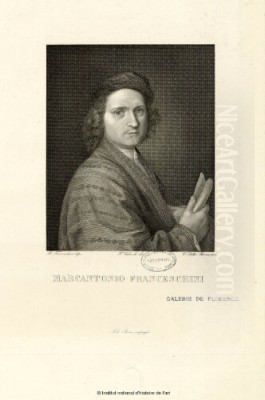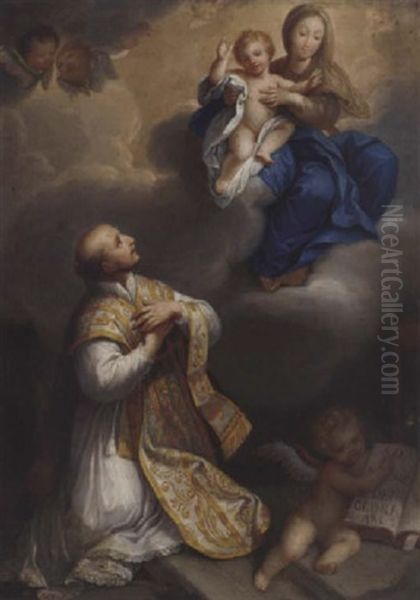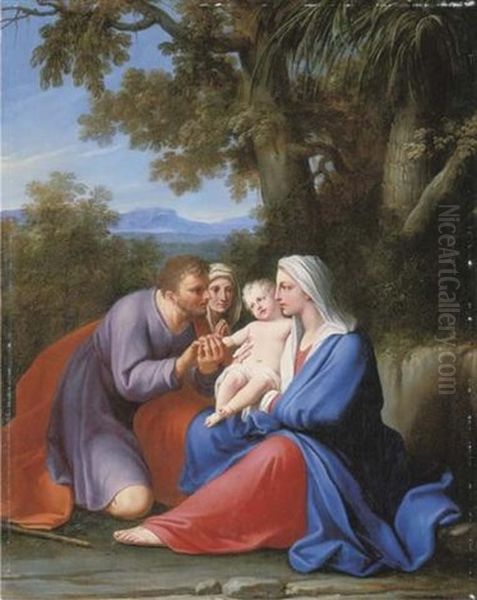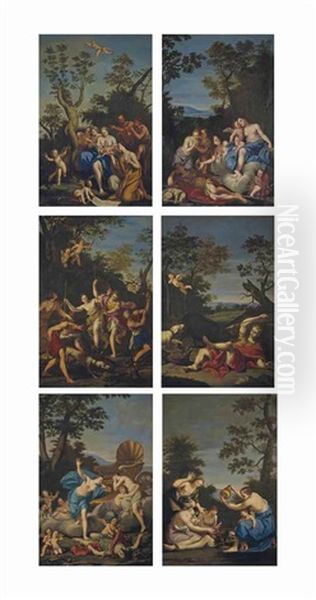
Marcantonio Franceschini stands as a pivotal figure in the landscape of Italian art during the transition from the High Baroque to the Late Baroque and early Rococo periods. Born in Bologna in 1648 and living a long and remarkably productive life until his death in 1729, Franceschini became one of the most sought-after painters of his time, renowned for his elegant decorative schemes, religious narratives, and mythological scenes. His work, deeply rooted in the classical tradition of the Bolognese school, evolved into a refined, graceful style that found favour not only in his native city but across Italy and among prominent European patrons. He represents the culmination of a specific artistic lineage, adapting the lessons of the Carracci and their followers to the tastes of the late seventeenth and early eighteenth centuries.
Early Life and Artistic Formation
Marcantonio Franceschini's artistic journey began in Bologna, a city with a rich artistic heritage, particularly famed for the academy founded by the Carracci family – Ludovico, Agostino, and Annibale Carracci – almost a century earlier. This tradition emphasized strong drawing skills (disegno), clarity of composition, and a return to naturalism tempered by classical ideals, reacting against the perceived artificiality of late Mannerism. Franceschini entered this vibrant artistic environment, initially, according to some accounts, studying perspective and architecture, possibly under Giovanni Maria Galli da Bibiena, a member of the celebrated family of theatrical designers and quadratura painters.
However, his most significant training came under the tutelage of Carlo Cignani (1628-1719), who was himself a leading figure in the Bolognese school and a student of Francesco Albani, one of the Carracci's most important pupils. Cignani's style was characterized by its elegance, soft modelling, and sweet sentiment, often seen as a more refined and graceful continuation of the Bolognese classical tradition. Franceschini absorbed these qualities deeply, becoming Cignani's most talented student and, eventually, a close collaborator.
The Workshop of Carlo Cignani

The relationship between Cignani and Franceschini was formative. Franceschini spent many years in Cignani's workshop, progressing from student to trusted assistant. This period provided him with invaluable experience, particularly in the demanding technique of fresco painting and the organization required for large-scale decorative projects. They worked together on several significant commissions, allowing Franceschini to hone his skills while contributing to major works.
One notable collaboration was at the Olivetan Monastery of San Michele in Bosco, overlooking Bologna. Here, Cignani and his workshop, including Franceschini, executed important frescoes. Working alongside his master, Franceschini learned not only the technical aspects of painting but also the business side of art, dealing with patrons and managing complex projects. Cignani's influence is evident in Franceschini's early independent works, particularly in the graceful rendering of figures and the harmonious use of colour. However, even while working closely with Cignani, Franceschini began to develop his own distinct artistic personality, often favouring clearer outlines and a slightly cooler palette than his master.
Emergence as an Independent Master
By the 1680s, Marcantonio Franceschini had established himself as an independent master with his own thriving workshop in Bologna. His reputation grew rapidly, built upon his technical proficiency, reliability, and an elegant style that appealed to the prevailing taste. He began receiving significant commissions for both frescoes and easel paintings, primarily for churches and palaces in Bologna and the surrounding Emilia-Romagna region.
His independent style solidified during this period. While retaining the classical underpinnings learned from Cignani and the Carracci tradition – emphasizing balanced compositions, idealized figures, and narrative clarity – Franceschini developed a distinctive elegance and refinement. His figures possess a graceful poise, often arranged in harmonious, almost choreographed, groups. His colour palette became characteristic: clear, bright, and often employing delicate pastel shades alongside richer tones, contributing to the overall lightness and decorative quality of his work. This blend of Baroque dynamism with classical restraint and a burgeoning Rococo sensibility led some later critics to categorize his style, perhaps somewhat simplistically, as "Barochetto."
Major Decorative Cycles
Franceschini excelled in large-scale decorative fresco cycles, which became a significant part of his oeuvre. His ability to manage complex compositions covering vast wall and ceiling surfaces, often integrating figure painting with architectural frameworks (quadratura), made him highly sought after for the adornment of palaces and churches.
Bolognese Commissions

In Bologna, Franceschini left an indelible mark on numerous important buildings. One of his most celebrated works is the ceiling decoration in the Palazzo Ranuzzi (now the Palazzo di Giustizia), executed in the 1680s. He also undertook extensive work for the Corpus Domini church, creating not only altarpieces but also contributing significantly to the overall decorative scheme, including the poignant Death of St. Joseph. He painted frescoes and canvases for other major churches like San Bartolomeo and the Metropolitan Cathedral of San Pietro, demonstrating his versatility in handling diverse religious themes within grand architectural settings. His earlier work at San Michele in Bosco also remained a testament to his skills in fresco.
Commissions Beyond Bologna
Franceschini's fame quickly spread beyond his native city. In Parma, he contributed decorations to the Duomo (Cathedral), adding to the rich artistic layering of that important edifice. He also worked for the Este court in Modena, further cementing his reputation among the ruling families of Northern Italy. In Piacenza, he received commissions for the Duomo, demonstrating the demand for his elegant style across the region.
Perhaps his most ambitious project outside Bologna was the decoration of the Great Council Chamber in the Palazzo Ducale (Doge's Palace) in Genoa. Commissioned in 1701-1702, this vast undertaking involved depicting scenes from the history of the Genoese Republic. Franceschini spent considerable time in Genoa executing these frescoes, which were widely acclaimed upon completion. Tragically, this masterpiece was destroyed by fire in 1777, leaving only preparatory drawings and oil sketches (bozzetti) to hint at its former grandeur. Despite this loss, the commission itself speaks volumes about Franceschini's stature as one of Italy's leading decorative painters.
Religious and Mythological Easel Paintings
Alongside his monumental fresco work, Franceschini maintained a prolific output of easel paintings, primarily oil on canvas. These works often treated religious subjects, ranging from large altarpieces to smaller devotional images, as well as mythological themes popular with private collectors. His approach remained consistent with his fresco style: clarity, elegance, and a focus on graceful figures and harmonious compositions.
Examples in the Pinacoteca Nazionale di Bologna, such as the Annunciation and various depictions of the Madonna and Child or the Holy Family, showcase his characteristic style. These works feature idealized figures rendered with smooth precision, clear, luminous colours, and a gentle, pious sentiment that avoids excessive drama. His Death of St. Joseph (part of the Corpus Domini commission but also existing as easel paintings) is noted for its tender pathos, capturing the quiet solemnity of the scene.

Mythological subjects allowed Franceschini to explore themes of classical antiquity, often focusing on narratives involving gods, goddesses, and nymphs. These paintings, frequently commissioned for palace interiors, display a similar elegance and decorative sensibility, emphasizing beauty and grace over dramatic intensity. His figures, whether divine or human, possess an almost porcelain-like finish and move with balletic grace.
Patronage and International Reputation
Marcantonio Franceschini enjoyed patronage from the highest levels of society. In Bologna, noble families like the Ranuzzi and Marescotti commissioned extensive decorations for their palaces. Ecclesiastical bodies were major patrons, commissioning altarpieces and frescoes for numerous churches and monasteries. His reputation reached Rome, leading to a prestigious commission from Pope Clement XI to design cartoons for mosaics in the Presentation Chapel of St. Peter's Basilica around 1712, a significant honour confirming his national standing.
Perhaps his most significant international patron was Prince Johann Adam Andreas I von Liechtenstein. Between 1692 and 1709, the Prince commissioned a large number of works from Franceschini, primarily religious and mythological easel paintings, which formed a substantial part of the famous Liechtenstein collection. These works, many still held by the Princely Collections in Vaduz and Vienna, demonstrate the appeal of Franceschini's refined style to sophisticated European collectors. There were also connections to the court in Vienna, possibly through patrons like Prince Eugene of Savoy, who appreciated Italian art.
Franceschini's success brought him honours, including a knighthood (likely the Order of Christ, granted by the Pope), which earned him the title 'Cavaliere'. A famous anecdote, recounted by his biographer Giampietro Zanotti, claims that Franceschini declined invitations to work abroad, including potentially one from Louis XIV of France, preferring to remain in his beloved Bologna. While the specifics might be embellished, it reflects his strong ties to his native city and his immense success within Italy, which perhaps made foreign ventures unnecessary.
Artistic Style: The Essence of Late Bolognese Classicism
Franceschini's style is best understood as a refined evolution of Bolognese classicism, adapting the principles of the Carracci school to the sensibilities of the late Baroque era. Key elements include:
Drawing and Clarity: Following the Carracci emphasis on disegno, Franceschini's work is underpinned by strong, clear drawing. Figures are well-defined, and compositions are legible and balanced, avoiding the tumultuous complexity found in some Roman Baroque works.
Idealization and Grace: His figures are highly idealized, conforming to classical notions of beauty. They move with an effortless grace and elegance, sometimes described as slightly detached or serene. This contrasts with the intense emotionalism often found in High Baroque art. Francesco Albani's influence, transmitted through Cignani, is particularly evident in this aspect.
Colour and Light: Franceschini employed a clear, often bright and luminous colour palette. While capable of rich tones, he frequently used lighter, cooler colours and delicate harmonies that contribute to the decorative effect and anticipate Rococo palettes. His handling of light is typically even and clarifying, rather than employing dramatic chiaroscuro.
Composition: His compositions are carefully structured, often based on stable symmetrical arrangements or clear diagonal movements. He masterfully organized large groups of figures in his frescoes, ensuring harmony and legibility across vast surfaces.
Sentiment: The emotional tone of his work is generally restrained and gentle. Religious scenes often convey a sweet piety or tender pathos, while mythological subjects emphasize grace and beauty rather than intense passion or conflict.
While sometimes labelled "Barochetto," implying a transition towards Rococo, Franceschini's style retains a fundamental classicism and seriousness that distinguishes it from the lighter, more playful spirit of full-blown Rococo. He represents the final flowering of the great Bolognese classical tradition, infusing it with a new elegance and decorative refinement suited to the tastes of his time.
Collaboration and Workshop Practice
Like many successful artists of the period, especially those undertaking large decorative projects, Franceschini relied on a well-organized workshop and frequent collaboration with specialists. This was essential for completing complex commissions efficiently and to a high standard.
His most consistent collaborator was Luigi Quaini (1643-1717), a fellow Bolognese painter who often worked alongside Franceschini for decades. Quaini specialized in landscape and architectural backgrounds, and his contributions are seamlessly integrated into many of Franceschini's frescoes and larger canvases. Their partnership was remarkably harmonious and productive.
Franceschini also collaborated with quadratura specialists, painters who created illusionistic architectural settings for his figures. Early in his career, this might have involved members of the Galli Bibiena family. Later, Enrico Haffner (1640-1702) and his brother Antonio Haffner were among those who provided sophisticated architectural frameworks for Franceschini's frescoes, enhancing the overall illusionistic effect.
His workshop included numerous assistants and pupils who learned his style and methods. His own son, Giacomo Franceschini (1672-1745), became a painter in his father's manner, assisting him on projects and later working independently, though never achieving his father's level of fame. Other documented pupils include Antonio Rossi (active early 18th century), who carried the style to Florence, and Giuseppe Marchesi (1699-1771), known as Il Sansone, who became a notable painter in Bologna in the generation after Franceschini. The workshop system ensured the propagation of his style and allowed him to manage his extensive commissions.
The Accademia Clementina
In the later part of his career, Franceschini played an important role in the institutional life of Bolognese art. He was a founding member of the Accademia Clementina, established in Bologna in 1710 under the patronage of Pope Clement XI. This academy aimed to uphold the standards of the Bolognese artistic tradition and provide formal training for young artists, effectively succeeding the earlier Carracci academy.
Franceschini's stature and reputation made him a natural leader within the new institution. He was elected Principe (President or Director) of the Accademia Clementina, a position of considerable honour, reflecting the high esteem in which he was held by his peers. His involvement lent prestige to the academy and helped solidify its role as the central artistic institution in Bologna for much of the 18th century. He represented the living link to the great tradition he had inherited and adapted.
Later Years and Legacy
Marcantonio Franceschini remained active well into his old age, a testament to his enduring energy and the continued demand for his work. He passed away in Bologna in 1729 at the venerable age of 81, having dominated the city's artistic scene for decades.
His immediate legacy was carried on by his son Giacomo and pupils like Giuseppe Marchesi (Il Sansone). His elegant, classical style provided a counterpoint to the more painterly and emotionally charged work of contemporaries like Giuseppe Maria Crespi (1665-1747) and the refined, slightly melancholic classicism of Donato Creti (1671-1749). Franceschini's influence extended through the 18th century, representing a standard of academic correctness and decorative grace.
While later Neoclassical tastes might have found his work lacking in severity, and Romantic sensibilities might have missed dramatic intensity, Franceschini's art perfectly encapsulated the refined aesthetics of the late Baroque period. He successfully synthesized the strength of the Bolognese classical tradition with a new elegance and lightness, creating a style that was both sophisticated and widely appealing. His prolific output, technical mastery, and international reputation secure his place as a major figure in Italian art history, a master decorator who brought the legacy of the Carracci into the eighteenth century with grace and distinction.
Conclusion
Marcantonio Franceschini was more than just a prolific painter; he was a defining artist of his era in Bologna and a significant figure on the broader Italian and European stage. Through his apprenticeship with Carlo Cignani, he inherited the mantle of the Carracci tradition, which he skillfully adapted to create a distinctive style characterized by classical balance, graceful figures, clear narratives, and harmonious colour. His mastery of both fresco and oil painting led to major commissions for palaces and churches across Northern Italy and prestigious patronage from popes and princes. His role in founding and leading the Accademia Clementina underscores his importance to the artistic life of Bologna. As a master of Late Bolognese Classicism, Franceschini created a vast body of work that exemplifies the elegant transition from the grandeur of the High Baroque to the refined sensibilities of the eighteenth century.